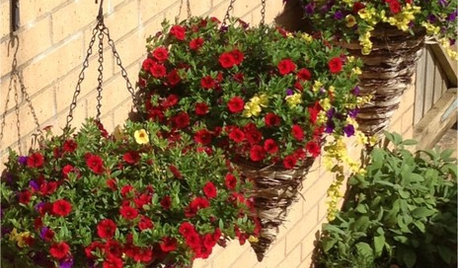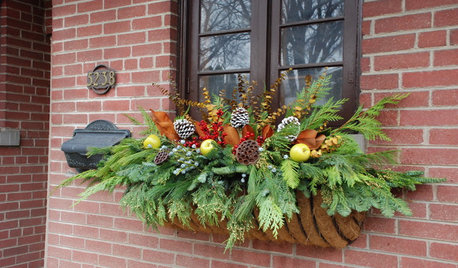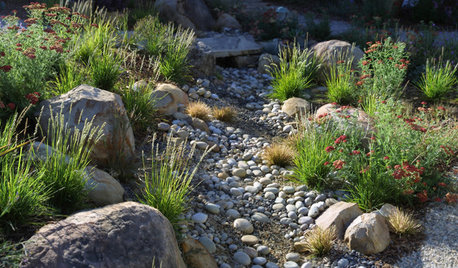Container Soils - Water Movement & Retention XIV
tapla (mid-Michigan, USDA z5b-6a)
12 years ago
Featured Answer
Sort by:Oldest
Comments (164)
fortyonenorth
12 years agolast modified: 9 years agotinyfrogs
12 years agolast modified: 9 years agoRelated Discussions
Container Soils - Water Movement & Retention X
Comments (153)Not at all, and I don't remember writing anything that should leave anyone with that impression. If I had to identify the crux of the thread, it would be that to take advantage of highly aerated media and their sharp drainage, it's essential to start with a very large volume of coarse ingredients, and there should never be enough fine material to fill all the spaces between the large particles. When you add a marble/perlite) to a jar filled to the rim with sand or peat), aeration of the medium in the jar DECREASES, and continues to decrease as you add more marbles/perlite. It is only when you have added a volume of marbles/perlite) so large there is not enough sand/peat) to fill all the desirable pores between the large particles that aeration begins to INCREASE. This is called the "threshold proportion". Al...See MoreContainer Soils - Water Movement & Retention XIII
Comments (152)Hello Al - thanks again for all of your posts and the fruits of your research. I am growing four heirloom tomato plants in containers using your 5-1-1 mix. Here in Raleigh the closest thing I could find to pine bark fines was a product by Timberline called "Soil Conditioner" which seems to be close to the ideal size. But I wanted to ask you two questions, which I hope you have the time to answer (and patience, if you've already answered them - I looked and could not find your thoughts on these): 1. I used a run of the mill mulch to top off my 5-1-1 mixes in the pots and to my dismay discovered the mulch was full of fungus gnats. I will try Gnatrol to get rid of them, but it brings up my question - what do you use for mulch for the 5-1-1? Maybe pine bark nuggets instead of this buggy shredded hardwood I'm using? (large size might help to avoid insect eggs or other stuff hiding inside?) Or do you not mulch? 2. And secondly, what do you use for day to day pest control? I'm spraying insecticidal soap almost daily to kill the whiteflies/thrips/aphids that I see on the leaves but I wonder if there's anything better I can do instead of using the toxic stuff (Sevin, etc). Thanks!...See MoreContainer Soils - Water Movement and Retention XX
Comments (150)Yes, I stated that I'm not worried about the aluminum, all the same I won't use aluminum sulfate either. Although it may be safe, I worry about toxic levels. Just because lead is in all soils doesn't mean it's a good idea to add more. Same with aluminum. And if you mix turface without a mask, you will be exposed to it. As far as water absorption Axis noted that turface holds 95% of it's weight in water. Pumice only holds 15% and DE holds 142% Try diatomaceous earth in your tests. Optisorb is about the largest size available to home gardeners. Axis makes an excellent size, but is for commercial use only. Numerous studies document it's use as superior to most other amendments. Such as " Effects of diatomite on soil consistency limits and soil compactibility" by Ekrem Lutfi Aksakala, Ilker Anginb, , , and Taskin Oztasa Or "Effects of diatomite on soil physical properties" by the same authors. Also "Sustainable effects of diatomite on the growth criteria and phytochemical contents of Vicia faba plants." Mona M. Abdalla* Department of Botany, Faculty of Science, Ain Shams University, Cairo, Egypt. The Axis company also has great info on all amendments. As far as particle size, do a test. Fill a pot with sand, and one with gravel. Stick a pole in, and see which one gives more resistance. It seems to me gravel would. But I might be wrong? I don't know physics well enough to figure it out on paper. Ah and pumice is further dashed to the ground and called a fake, not a single user rises to defend. Well we can agree to disagree, my day job is a laboratory researcher,or was, I'm retired. If turface has various pore sizes then it is not very well made. Thanks for pointing that out. So you do not believe the manufacturer? Controlling pore size in fired clays is often accomplished with the use of polymers such as Polyethylene glycol. This process is extremely important to control how well purifiers work, or how well they hold up with the addition of salts. You are incorrect about the pore size. Yes pore sizes differs, but that process is used to make different products, and is very controlled. Turface is meant to have small pores size or it would ineffective in it's intended use. The porosity of fired clays is extremely important to have a consistent product such as fired brick used to built houses. Varying pore sizes will compromise the strength of the brick. Selling a product and manufacturing one are very different things. The pore size I reported is for calcinated clay. Range of pore sizes is from .1 -.01 microns. Median is .045 . Plants need a .2 micron minimum pore size to utilize. This info is from a study by Andreas Kalytta-Mewes, Kathrin Mattern, and Armin Reller University of Augsburg, Chair of Solid Body Chemistry Georg Armbruster Soil Laboratory. The pore analysis in the study was conducted by Quantachrome,Bavarian Institute of Applied Environmental Research and Applied Technology. Of course it appears none of these sources trump Al. Who has not provided any data at all to back his claims. Please prove to me that pore size is bigger, thinking Al is right because you sell clay products is not proof. After saying all this will turface work? Yes, it will. Works pretty good! Is it ideal? No, it's not, but what is? It's still worth trying for sure. It didn't work for me, but that means nothing. it has worked well for others. It would be nice if it allowed easier access to stored water, but it does store water, and air, and it lasts a long time, maybe 20 years. That's decent. It's a decent product, or appears to be. It would not be on the market if it didn't work. I know it's not meant for potted plants, but it is meant for grass. DE seems a better product, it has it's own problems. it is marketed though for plants more than ball fields, although it is marketed for that too. It's marketed for large commercial gardens. I use it in my garden. I use turface too for my grass, works well. Just not that well in pots for me. All i said that it didn't work for me. Sorry blame me, it's what you usually do when the mixes fail, you blame the poster. Many have said DE doesn't work for them. I actually believe them. All gardening is local. This post was edited by Drew51 on Mon, Dec 29, 14 at 15:33...See MoreContainer Soils - Water Movement & Retention XII
Comments (150)Hi, Just curious, I have a question about sphagnum peat vs sphagnum moss. By mistake, I purchased sphagnum moss at the onset of making the 511 mix. I mixed one batch and used it for one of my 3 plants. When I realized that I was using the moss instead of the sphagnum peat, I threw it out and purchased the correct one and used it to make the mix for the other 2 plants I have. My question is this, is it possible that the presence of the sphagnum moss in this one container could somehow attract any pests? The reason I ask is that I saw about a couple of black, winged, fast-moving pests (maybe thrips or gnats?) around this plant today. Upon further inspection, I shuffled some of the top mix and saw a single, tiny larva(e) crawling in the medium and suspected that I have pests breeding in my container. And afterwards, as I shook the container, a fast crawling, winged pest climbed out of the mix, and up the side of the container. I sprayed this plant with some insecticdal soap and plan on repotting it using the sphagnum peat moss instead. So could this (sphagnum moss) be the reason for pest-sightings? I want to solve a potential big problem now, before the real bug season begins. By the way, I haven't watered this plant for like a week and it still seems to be moist inside. I had watered every 3 days prior to the last time....See Moretapla (mid-Michigan, USDA z5b-6a)
12 years agolast modified: 9 years agoskycopp
12 years agolast modified: 9 years agotapla (mid-Michigan, USDA z5b-6a)
12 years agolast modified: 9 years agoskycopp
12 years agolast modified: 9 years agotapla (mid-Michigan, USDA z5b-6a)
12 years agolast modified: 9 years agoivanaz
12 years agolast modified: 9 years agotapla (mid-Michigan, USDA z5b-6a)
12 years agolast modified: 9 years agoBob1016
12 years agolast modified: 9 years agotapla (mid-Michigan, USDA z5b-6a)
12 years agolast modified: 9 years agoBob1016
12 years agolast modified: 9 years agoivanaz
12 years agolast modified: 9 years agotapla (mid-Michigan, USDA z5b-6a)
12 years agolast modified: 9 years agotapla (mid-Michigan, USDA z5b-6a)
12 years agolast modified: 9 years agotecnico
12 years agolast modified: 9 years agotapla (mid-Michigan, USDA z5b-6a)
12 years agolast modified: 9 years agotecnico
12 years agolast modified: 9 years agossmdgardener
12 years agolast modified: 9 years agotecnico
12 years agolast modified: 9 years agotecnico
12 years agolast modified: 9 years agotecnico
12 years agolast modified: 9 years agotapla (mid-Michigan, USDA z5b-6a)
12 years agolast modified: 9 years agotecnico
12 years agolast modified: 9 years agoLoveplants2 8b Virginia Beach, Virginia
12 years agolast modified: 9 years agotecnico
12 years agolast modified: 9 years agotecnico
12 years agolast modified: 9 years agotapla (mid-Michigan, USDA z5b-6a)
12 years agolast modified: 9 years agotecnico
12 years agolast modified: 9 years agotecnico
12 years agolast modified: 9 years agoskycopp
12 years agolast modified: 9 years agossmdgardener
12 years agolast modified: 9 years agoskycopp
12 years agolast modified: 9 years agossmdgardener
12 years agolast modified: 9 years agoskycopp
12 years agolast modified: 9 years agossmdgardener
12 years agolast modified: 9 years agoLinda
8 years agolast modified: 8 years agotapla (mid-Michigan, USDA z5b-6a)
8 years agoLinda
8 years agoethanqsimmons
8 years agotapla (mid-Michigan, USDA z5b-6a)
8 years agomblan13
8 years agotapla (mid-Michigan, USDA z5b-6a)
8 years agojer348
7 years agolast modified: 7 years agotapla (mid-Michigan, USDA z5b-6a)
6 years agolast modified: 6 years agotapla (mid-Michigan, USDA z5b-6a)
6 years agomichael_europe_zone8b
5 years agoTanner B. Hess Webber
3 years ago
Related Stories

CONTAINER GARDENSContainer Gardening Basics: The Dirt on Soil
Learn the types of potting soil available and the best mixes to help your containers thrive
Full Story
GARDENING GUIDES10 Solutions for Soggy Soil
If a too-wet garden is raining on your parade, try these water-loving plants and other ideas for handling all of that H2O
Full Story
GARDENING GUIDESHow to Stop Worrying and Start Loving Clay Soil
Clay has many more benefits than you might imagine
Full Story
GARDENING GUIDESHow to Pick a Mulch — and Why Your Soil Wants It
There's more to topdressing than shredded wood. Learn about mulch types, costs and design considerations here
Full Story
GARDENING GUIDESGreat Design Plant: Anemone Canadensis Adds Pizzazz to Water’s Edges
Plant Canadian anemone along pond, lake or stream edges for a splash of white flowers in late spring
Full Story
CURB APPEALCrazy for Colorful Cones: 5 Container Plantings Beyond the Bowl
Give even a small garden an exuberant vibe with hanging cones overflowing with blooming beauties
Full Story
FARM YOUR YARDHow to Grow Vegetables in Containers
Get glorious vegetables and fruits on your patio with a pro’s guidance — including his personal recipe for potting mix
Full Story
GARDENING GUIDES10 Dazzling Winter Container Designs
Get inspired by these ideas for festive arrangements in outdoor pots and planters
Full Story
GARDENING GUIDESHow to Install a Drip Irrigation System
Save time and water with a drip watering system in your vegetable garden — a little patience now will pay off later
Full Story
LANDSCAPE DESIGNHow to Design Your Landscape to Slow Down Water
Putting the brakes on stormwater runoff is the first step in sustainable water design
Full Story



Byrd and Cook